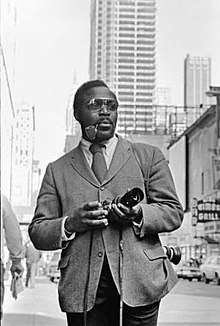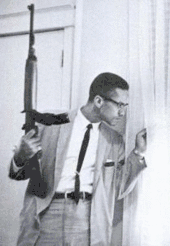Don Hogan Charles
Don Hogan Charles (September 9, 1938 – December 15, 2017)[1] was an American photographer. He was the first African-American staff photographer hired by The New York Times.[2] In his four decades there, Charles photographed notable subjects including Coretta Scott King, John Lennon, Malcolm X and Muhammad Ali.
Don Hogan Charles | |
|---|---|
 Hogan Charles photographed in the late 1960s. | |
| Born | Don Hogan Charles September 9, 1938 |
| Died | December 15, 2017 |
| Nationality | American |
| Occupation | Photographer |
Life and work
Charles was born "Daniel James Charles" in New York City on September 9, 1938 to James Charles and Elizabeth Ann Hogan.[1] He attended George Washington High School in Manhattan and went on to study engineering at City College of New York before dropping out to pursue photography.[1]
In 1964, after leaving City College, Charles joined The New York Times and remained there for 43 years, until he retired in 2007.[1]
Before joining The Times he worked as a freelance photographer. Charles's freelance work appeared in major international publications such as Der Spiegel and Paris Match. His commercial clients included Bill Blass, Oscar de la Renta and Pan American World Airways.[3]
Charles' work is in the collections of MOMA and the National Museum of African American History and Culture.[4][5]

Among the iconic photos taken by Charles was one of human rights activist Malcolm X holding an M1 carbine while peering out a window. The photo, which Charles took for Ebony, became emblematic of the determination of Malcolm X to protect his family "by any means necessary".[6][7]
Notable photographs
References
- Chokshi, Niraj (December 2, 2017). "Don Hogan Charles, Lauded Photographer of Civil Rights Era, Dies at 79". The New York Times. ISSN 0362-4331. Retrieved December 26, 2017.
- Helm, Angela (December 24, 2017). "Photographer Don Hogan Charles, Who Shot Iconic Photo of Malcolm X at His Window, Has Died". The Root. Retrieved December 24, 2017.
- Rawlins, Randolph Jimmy (February 1982). "The World of Commercial Photographers". Black Enterprise.
- "Don Hogan Charles/The New York Times | MoMA". The Museum of Modern Art. Retrieved December 26, 2017.
- "Photograph of a boy walking ahead of soldiers during the Newark Riots". National Museum of African American History and Culture. Retrieved December 26, 2017.
- Lord, Lewis; Thornton, Jeannye; Bodipo-Memba, Alejandro (November 15, 1992). "The Legacy of Malcolm X". U.S. News & World Report. p. 3. Archived from the original on January 14, 2012. Retrieved December 24, 2017.
- Massaquoi, Hans J. (September 1964). "Mystery of Malcolm X". Ebony. pp. 38–40, 42, 44–46. Retrieved December 24, 2017.